| List of Pipe Organ Profiles | Pipe Organ Profiles Home | N8RRB Home | E-mail the Webmaster |
| St. Agatha Catholic Church - 2/43 Bedient | Main Page | Great Division | Swell Division | Pedal Division | Console | Facade |
Other Photos | Stop List |
St. Agatha Catholic Church
Upper Arlington, OH
2/43 Bedient
Opus 75 - 2005
Organ Console
Click on the photo to get a larger image.
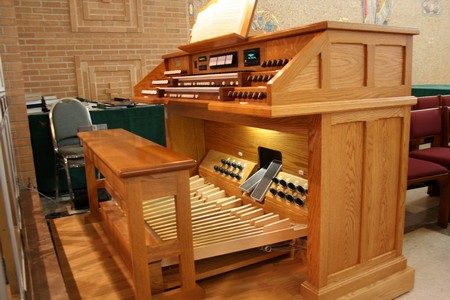 |
The console for this organ is much smaller in width than most organ consoles. In fact it's not much wider than a standard upright piano (minus the pedal board). The console sits on a platform which can be easily moved around the altar area. By comparison, the old organ's console sat on a fixed platform covered with "ugly shag carpeting." The gray cable on the left is the control cable from the console to the pipe chamber. |
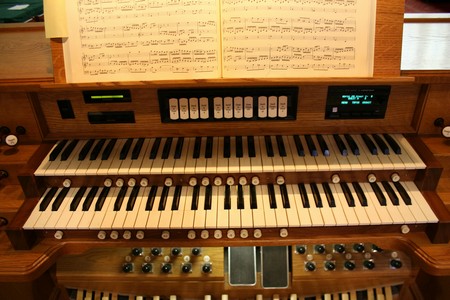 |
Here's a good view of what the organist sees when sitting at the console. Most organ consoles have only 61 keys instead of the full 88 keys on a piano. In the center are couplers which couple divisions of the organ together on each manual or keyboard. Normally, the Swell division would be played on the top manual, and the Great division would be played on the bottom manual. Selecting a coupler brings the resources of both divisions to the same manual. Most of the buttons under the keys are replicated at the bottom with toe studs, thus allowing the organist to select via hand or foot. |
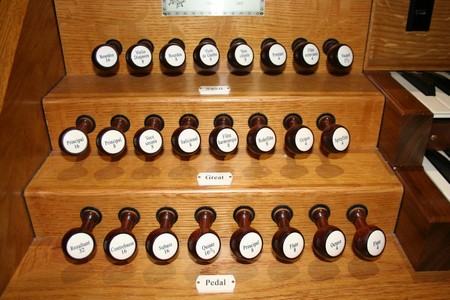 |
The stop knobs on this organ are tiered in a stair step format rather than being even on a panel. Each level represents a division of the organ (Swell, Great, Pedal). Also note how the names of the stop knobs are angled toward the center of the console for easy viewing by the organist. These stop knobs are on the left side of the console. |
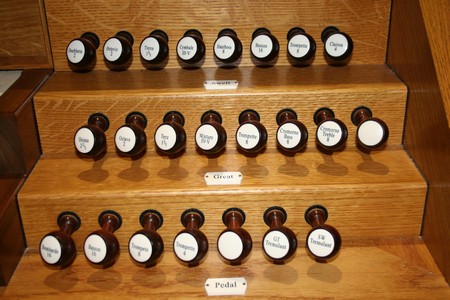 |
Here are the stop knobs on the right side of theorgan console. Note that the Cymbale and Mixture stops have two roman numerals next to them. This indicates the number of ranks of pipes in the stop. For example, the Mixture IV-V stop has five ranks meaning that pressing one key on the manual or keyboard will play five pipes. However it drops a rank probably at either end of the scale, thus the notation IV-V. Also note the two blank stop knobs, thus allowing for some expansion of the organ. |
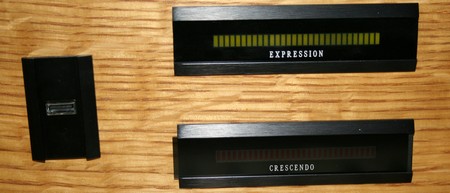 |
Like most organs, this organ has indicators for Expression (Swell) and Crescendo. The photo shows full scale for the Expression meaning that the Swell shades are completely open. The Crescendo is dark indicating that the Crescendo pedal is not being depressed. |
 |
Here's something J.S. Bach would not recognize on the organ! The computer system shown here allows the organist to do a number of things. First, multiple organists can maintain their preset registrations in memory (currently "Guest A" organist is selected). The organ also has four programmable crescendos meaning that the organ can be programmed to add stops in the sequence as desired by the organist. Another feature is the ability to transpose on the spot. Instead of the organist transposing the music on the organ to a higher or lower key, the organist can select the transpose function and move the knob to switch to a higher or lower key. So if the organist moves the knob to one step lower, pressing C on the organ will result in the note B being played by the organ. |
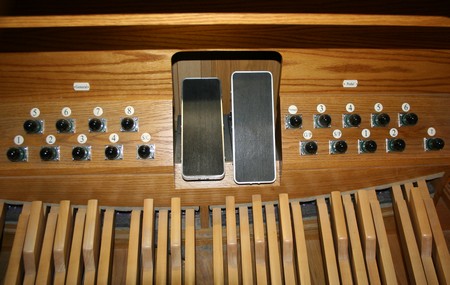 |
Down below we see the pedal board (most of it), toe pistons and the expression and crescendo pedals. The most obvious thing to note is that the normally "black" pedal keys are white. This should not be an issue to the organist since technically the organist is not supposed to look at their feet while they play, apparently relying on the feel of the pedals keys to know where they are on the pedal board. |
 |
Here are the General toe studs or pistons on the leftside of the organ console. These perform the same function as the buttons on the manuals and allow the organist to preset a desired registration (selected stops) in advance. Pressing the toe stud will change the registration to the preset. The S/G toe stud is a coupler which couples the Swell division to the Great division. |
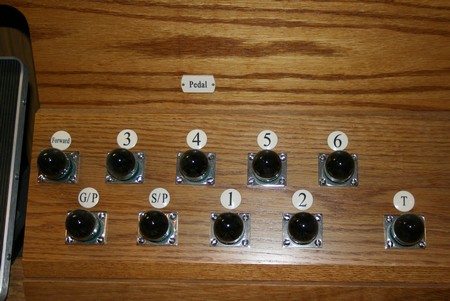 |
On the right side of the console are the Pedal toe studs. Those marked 1-6 are presets for the Pedal division only. There are also two couplers, one for Great to Pedal (G/P), and Swell to Pedal (S/P). The "Forward" toe stud is to advance to the next preset in memory. This is helpful when playing pieces which require multiple preset registrations. Hitting this toe stud moves to the next preset. Finally, the toe stud marked "T" is for Tutti, or full organ. |
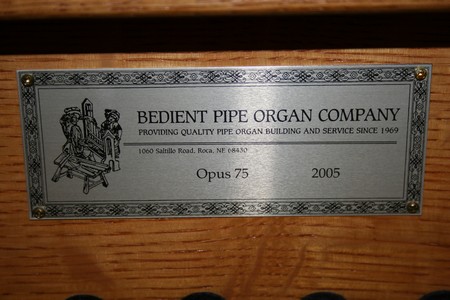 |
The
Bedient
Pipe Organ Company is a relatively new kid on the block, especially
considering some organ builders have been around for over 100 years.
According to their web
page, this is the fifth Bedient pipe
organ installed in Ohio. |
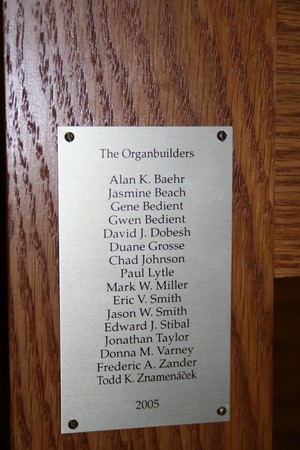 |
Tucked away on the left side of the console is this list of workers who helped build the organ. This is a nice touch by the builder, recognizing those individuals who spent many hours putting the instrument together. Organ building is a largely manual process, and in fact essentially needs to be put together in the factory before it is transported and installed. |
| St. Agatha Catholic Church - 2/43 Bedient | Main Page | Great Division | Swell Division | Pedal Division | Console | Facade | Other Photos | Stop List |